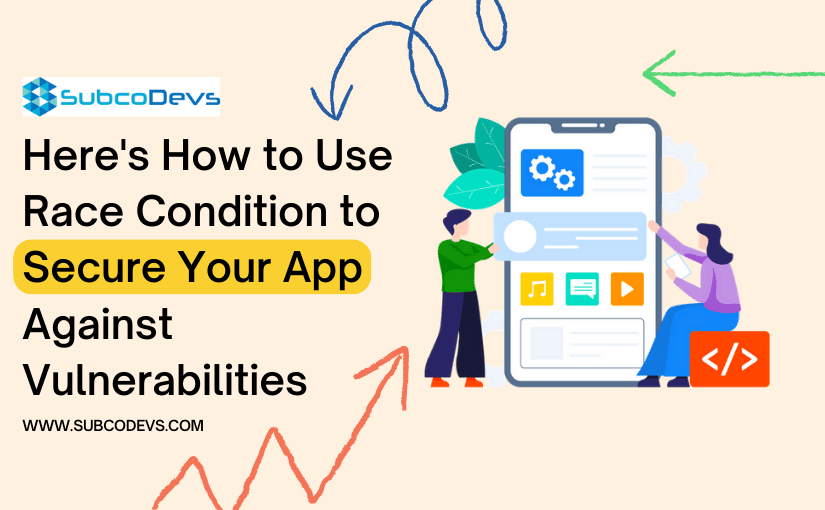In the realm of software development, crafting flawless applications involves more than just elegant coding. One often overlooked but potentially catastrophic concern is the race condition. For entrepreneurs steering their apps to success, comprehending and mitigating race conditions is a crucial step towards ensuring security and performance.
In this article, we’ll delve into the depths of race conditions, exploring their nuances, vulnerabilities, and strategies to fortify your applications against them.
Understanding the Race Condition
In the dynamic world of multi-threaded programming, a race condition emerges when two or more threads attempt to access shared resources concurrently, leading to unpredictable and undesirable outcomes. This is especially critical in scenarios where shared states can be inadvertently altered due to concurrent actions, impacting data integrity and application stability.
Types of Race Conditions
Race conditions can manifest in various forms, making them a significant concern for software developers. The most common types include:
- Check-Then-Act Race Conditions: This occurs when a thread checks a condition and acts upon it based on that condition. However, between the check and the action, another thread might modify the condition, leading to unexpected consequences.
- Read-Modify-Write Race Conditions: In this scenario, multiple threads read the same value, modify it based on some criteria, and write it back. If these actions occur concurrently, the changes made by one thread can be overridden by another, resulting in incorrect values.
- Critical Section Race Conditions: Threads access a critical section of code that operates on shared resources. If proper synchronization mechanisms are not in place, simultaneous access can lead to data corruption and unexpected behavior.
Vulnerabilities Arising from Race Conditions
Overlooking race conditions could expose your applications to significant security vulnerabilities. Here’s how race conditions can impact your app:
- Memory Location Manipulation: Race conditions can lead to threads altering memory locations they shouldn’t, leading to unexpected behavior and potentially crashing the application.
- Data Race Detector: Complex data races, often caused by race conditions, can trigger the data race detector, affecting application performance and responsiveness.
- Denial of Service (DoS): Malicious actors can exploit race conditions to launch DoS attacks, overloading your app with concurrent requests and rendering it unresponsive.
- Data Integrity Compromises: Critical data being altered by multiple threads simultaneously can lead to data corruption and inaccurate results, undermining the credibility of your app.
Avoiding Race Conditions
Mitigating race conditions requires a combination of best practices and effective strategies to ensure your app’s stability and security:
- Atomic Operations: Utilize atomic operations that ensure a specific operation on shared resources completes without interruption. Atomic operations prevent multiple threads from interfering with each other.
- Synchronization Mechanisms: Implement synchronization mechanisms like locks, semaphores, and mutexes to control access to critical sections of your code. This prevents multiple threads from accessing shared resources simultaneously.
- Thread Safety Practices: Design your application with thread safety in mind. Utilize design patterns that promote encapsulation and minimize the risk of concurrent modifications.
- Read-Only Sharing: When multiple threads need to access shared data, make sure that the data is read-only or copy-on-write. This avoids unintended modifications.
- Consistent State: Ensure that shared resources maintain consistent states throughout their lifecycle. This reduces the likelihood of race conditions occurring during transitions.
- Thorough Testing: Employ testing methodologies that simulate concurrent access to shared resources. This can help identify potential race conditions before they occur in the production environment.
- Data Segregation: If possible, segregate data that is likely to be concurrently accessed. By minimizing the overlap of shared data, you can reduce the chances of race conditions.
In Conclusion
Race conditions might be subtle adversaries, but they wield the power to wreak havoc on your app’s functionality and security. For entrepreneurs committed to the success of their apps, a deep understanding of race conditions is essential.
By identifying vulnerabilities, implementing proactive strategies, and adhering to best practices, you can shield your applications from the clandestine dangers of race conditions. As you navigate the intricate pathways of software development, the knowledge and defenses against race conditions will stand as essential pillars of your app’s resilience and success.
Want to get ahead of such issues? Reach our software repair experts to keep your app efficient and updated.
